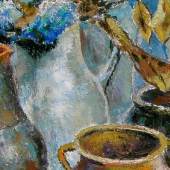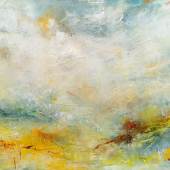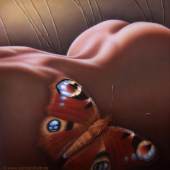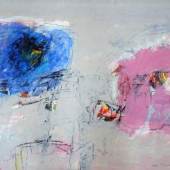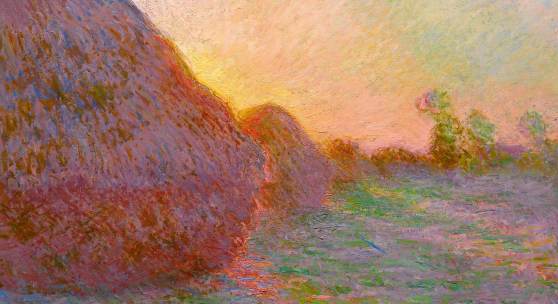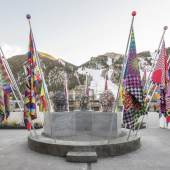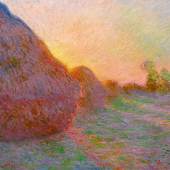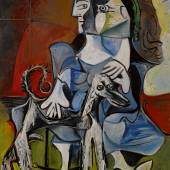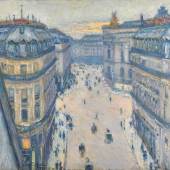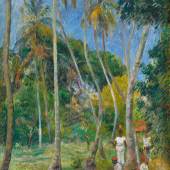Masterworks by Monet, Picasso & More to Highlight Sotheby’s Evening Sale of Impressionist & Modern Art
-
Auktion14.05.2019
WATCH: Picasso’s Idealized Portrait of His Final Muse
In October and November of 1968, Picasso executed a series of large canvases depicting flamboyant, sword-brandishing musketeers, including Mousquetaire à la pipe (estimate $20/30 million). One of the great subjects of the artist's late oeuvre, the musketeer was one of a cast of psychological avatars that were a means of projecting different aspects of his own identity. These portraits of the various archetypes that populated Picasso's personal mythology were part of a late flowering, a final synthesis which merged the artist's personal history with the cultural heritage of the Western artistic tradition, and developed a direct and spontaneous style that celebrated the act of artistic creation. In choosing the iconography shared by Old Master painters such as Rembrandt and Velázquez, Picasso was, at the end of his career, consciously aligning himself with the greatest artists of the Western canon.
WATCH: The Last Great Paintings by Pablo Picasso
THE MOST IMPORTANT PAINTING BY WILLIAM-ADOLPHE BOUGUEREAU EVER TO APPEAR AT AUCTION
Measuring an astounding 20-feet long and 11-feet tall, La Jeunesse de Bacchus (Youth of Bacchus) is the largest and most ambitious work of William-Adolphe Bouguereau’s career (estimate $25/35 million). Marking the first time that a work by the French academic painter will be offered in our marquee Evening Sale of Impressionist & Modern Art, the monumental masterpiece was presented in 1884 after two years of work, and had hung in Bouguereau's studio in Paris ever since, having previously left only three times in its 135-year history. On offer this spring by the direct descendants of the artist, La Jeunesse de Bacchus exemplifies Bouguereau’s extraordinary skill of conveying gesture and movement. With influences borrowed from the Greco-Roman period, classical 17th-century French painting and sculpture, as well as the work of his contemporaries, the sprawling canvas is arranged as a frieze, with 11 life-sized female and male figures parading across the composition. In the shadow on the left, two satyrs try to support Silenus, who teeters precariously atop a donkey, while on the right, two centaurs dance to the sound of a double flute. Their animated movements provide a distant echo of what takes place in the center of the composition, where a group of dancers form a circle around the figure who carries the child Bacchus on his shoulders.
WATCH: From Bouguereau’s Studio to Manhattan: How to Ship a Monumental Masterpiece
LUMIÈRES: THE LEVY FAMILY COLLECTION
An outstanding selection of works from the Levy Family Collection are led by exemplary paintings by Gustave Caillebotte, Paul Gauguin and Pierre Bonnard.
Painted in 1878, Gustave Caillebotte’s La Rue Halévy, vue du sixième étage is the embodiment of the new Paris that emerged in the middle of the 19th century (estimate $6/8 million). Created as the city underwent a dramatic reconfiguration, this expansive urban view epitomizes the way in which the Impressionists brought the French capital to life, rendered in Caillebotte’s own innovative pictorial style. As one of the most remarkable examples in the series of his urban landscapes, La Rue Halévy, vue du sixième étage portrays the bustling city from an elevated vantage point, with a plunging perspective and clear draughtsmanship, which characterize this radical and daring composition – among the artist’s greatest contributions to Modernism.
Paul Gauguin’s Chemin sous les palmiers epitomizes the artist’s fascination with the exotic and represents an enchanting vision of his life-long interest in depicting the unfamiliar (estimate $6/8 million). Painted in 1887, the vibrant oil is part of a series of works that Gauguin completed on his trip to the Caribbean island of Martinique, where the artist stayed from June until November of that same year, marking the beginning of his extraordinary association with the tropics. Martinique was Gauguin’s initial experience as an artist living within an island environment and foreshadowed the works he would later complete in Tahiti. Enthralled by the tropical landscape and native people who inhabited it, Gauguin’s strong desire for a life outside Europe was born in Martinique and ultimately came to fruition with his departure for Polynesia in 1891.
One of the most remarkable bathing scenes by Pierre Bonnard remaining in private hands, Femme à sa toilette (Le Peignoir) captures the beautifully complex reflection of the artist’s beloved wife and muse, Marthe de Méligny, during an intimate, everyday ritual (estimate $4/6 million). Measuring over 45 inches tall, the canvas depicts the sitter in a private moment just before undressing – unaware of the viewer, her gaze drifts toward her foot while she instinctively holds fast the opening of her robe. Always attuned to his surroundings and the familiar objects within them, Bonnard would increasingly depict interior and bathing scenes in his later years as he and his wife grew progressively more reclusive. By magnifying the scale of the scene, yet retaining the close composition of his earlier Intimist works, Bonnard directs all attention to the figure at center, compressing the room’s depth and conflating its multiple perspectives.
-
20.04.2022ARTEXPO NEW YORK CELEBRATES ITS 45TH ANNUAL EDITION WITH A RENAISSANCE IN CONTEMPORARY AND FINE...
-
12.04.2021 - 14.04.2021By Pak • 12- 14 April • A novel collection of digital art redefining our understanding...
-
23.05.2018NEW YORK, 16 May 2018 – Today, Sotheby’s is honored to unveil the full contents of A...
-
Zunehmend kamen auch realistische Strömungen nach Venedig. Die Künstler aus Brescia,...
-
20.04.2024 - 24.11.2024Jeffrey Gibson on Representing the United States and Himself By Melissa Smith | Feb 16, 2024 From...
-
11.12.2024Iconic Heuer Monaco Worn by Steve McQueen in LeMansRaces to Auction at Sotheby’s New York...
-
14.05.2019Auktion »
.
